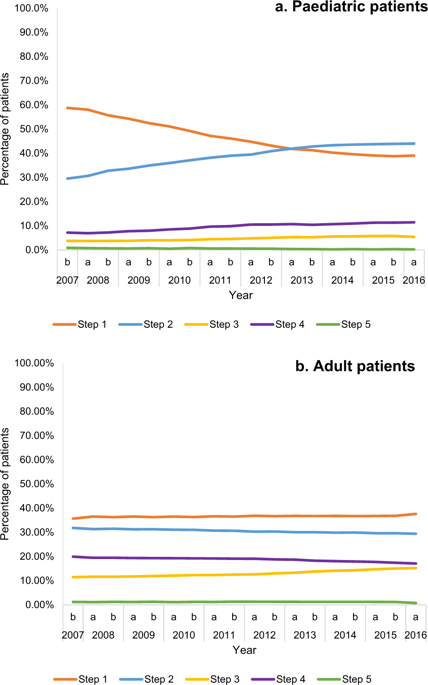当前位置:
X-MOL 学术
›
npj Prim. Care Respir. Med.
›
论文详情
Our official English website, www.x-mol.net, welcomes your feedback! (Note: you will need to create a separate account there.)
Real-life prescribing of asthmatic treatments in UK general practice over time using 2014 BTS/SIGN steps.
npj Primary Care Respiratory Medicine ( IF 3.1 ) Pub Date : 2019-07-11 , DOI: 10.1038/s41533-019-0137-7 Alicia Gayle 1 , Abigail Tebboth 1 , Marie Pang 1 , Florent Guelfucci 2 , Ramzi Argoubi 2 , Steven Sherman 3 , Vincent Mak 4
npj Primary Care Respiratory Medicine ( IF 3.1 ) Pub Date : 2019-07-11 , DOI: 10.1038/s41533-019-0137-7 Alicia Gayle 1 , Abigail Tebboth 1 , Marie Pang 1 , Florent Guelfucci 2 , Ramzi Argoubi 2 , Steven Sherman 3 , Vincent Mak 4
Affiliation

|
The 2014 British Thoracic Society (BTS) and Scottish Intercollegiate Guideline Network (SIGN) guidelines recommend a stepwise approach to asthma management. We investigated the management of asthma in primary care in the UK to understand how real-world practice compares with BTS/SIGN guidelines. Asthma patients were identified from the UK Clinical Practice Research Datalink from September 2006 to August 2016. Aims were to classify patients according to BTS/SIGN steps, describe the proportion of patients transitioning between steps and describe patient demographics and clinical characteristics per group. Overall, 647,308 patients with asthma were identified (40,096 aged 5-11 years; 607,212 aged 12-80 years). Most treated patients were in step 1 or 2 (88.3% of children/67.5% of adults in December 2007; 83.0% of children/67.0% of adults in June 2016). Most patients remained within their treatment step within a 6-month interval (>78% of children and adults throughout the study duration). The proportion of patients stepping up and down reduced from the beginning of the study, although stepping down to step 1 was relatively common in both adults and children. Few patients had a recorded asthma review in the year before reference date (18.8% of children and 14.8% of adults). Although prescribing patterns meant that most patients remained within their treatment step throughout the study, we cannot be sure that this was because their disease was truly stable. The small proportion of patients stepping up/down and the lack of recorded asthma review suggest that patients may not be treated in accordance with BTS/SIGN guidelines.
中文翻译:

使用2014 BTS / SIGN步骤,随着时间的流逝,英国一般实践中对哮喘治疗的现实处方。
2014年英国胸科学会(BTS)和苏格兰大学间指南网络(SIGN)指南推荐了一种循序渐进的哮喘管理方法。我们调查了英国基层医疗机构对哮喘的管理情况,以了解实际操作与BTS / SIGN指南的比较。从2006年9月至2016年8月,从英国临床实践研究数据链接中识别出哮喘患者。其目的是根据BTS / SIGN步骤对患者进行分类,描述各步骤之间过渡的患者比例,并描述每组患者的人口统计学和临床特征。总体上,确定了647,308名哮喘患者(5,096岁的5-11岁; 607,212岁的12-80岁)。大多数接受治疗的患者处于第1或第2步(2007年12月为88.3%的儿童/67.5%的成年人; 2016年6月为83.0%的儿童/67.0%的成年人)。大多数患者在6个月的间隔内仍处于治疗步骤之内(整个研究期间> 78%的儿童和成人)。从研究开始,上下步的病人比例就降低了,尽管下步到第1步在成年人和儿童中都比较普遍。在参考日期之前的一年中,很少有患者进行过哮喘复查的记录(18.8%的儿童和14.8%的成人)。尽管处方方式意味着大多数患者在整个研究过程中都处于治疗步骤之内,但我们不能确定这是因为他们的疾病真正稳定了。一小部分患者升/降以及缺乏记录的哮喘检查提示,可能未按照BTS / SIGN指南进行治疗。
更新日期:2019-07-11
中文翻译:

使用2014 BTS / SIGN步骤,随着时间的流逝,英国一般实践中对哮喘治疗的现实处方。
2014年英国胸科学会(BTS)和苏格兰大学间指南网络(SIGN)指南推荐了一种循序渐进的哮喘管理方法。我们调查了英国基层医疗机构对哮喘的管理情况,以了解实际操作与BTS / SIGN指南的比较。从2006年9月至2016年8月,从英国临床实践研究数据链接中识别出哮喘患者。其目的是根据BTS / SIGN步骤对患者进行分类,描述各步骤之间过渡的患者比例,并描述每组患者的人口统计学和临床特征。总体上,确定了647,308名哮喘患者(5,096岁的5-11岁; 607,212岁的12-80岁)。大多数接受治疗的患者处于第1或第2步(2007年12月为88.3%的儿童/67.5%的成年人; 2016年6月为83.0%的儿童/67.0%的成年人)。大多数患者在6个月的间隔内仍处于治疗步骤之内(整个研究期间> 78%的儿童和成人)。从研究开始,上下步的病人比例就降低了,尽管下步到第1步在成年人和儿童中都比较普遍。在参考日期之前的一年中,很少有患者进行过哮喘复查的记录(18.8%的儿童和14.8%的成人)。尽管处方方式意味着大多数患者在整个研究过程中都处于治疗步骤之内,但我们不能确定这是因为他们的疾病真正稳定了。一小部分患者升/降以及缺乏记录的哮喘检查提示,可能未按照BTS / SIGN指南进行治疗。



























 京公网安备 11010802027423号
京公网安备 11010802027423号